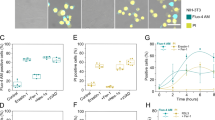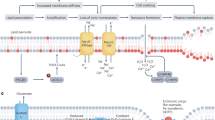Abstract
Ferroptosis is a regulated form of necrotic cell death that is caused by the accumulation of oxidized phospholipids, leading to membrane damage and cell lysis1,2. Although other types of necrotic death such as pyroptosis and necroptosis are mediated by active mechanisms of execution3,4,5,6, ferroptosis is thought to result from the accumulation of unrepaired cell damage1. Previous studies have suggested that ferroptosis has the ability to spread through cell populations in a wave-like manner, resulting in a distinct spatiotemporal pattern of cell death7,8. Here we investigate the mechanism of ferroptosis execution and discover that ferroptotic cell rupture is mediated by plasma membrane pores, similarly to cell lysis in pyroptosis and necroptosis3,4. We further find that intercellular propagation of death occurs following treatment with some ferroptosis-inducing agents, including erastin2,9 and C′ dot nanoparticles8, but not upon direct inhibition of the ferroptosis-inhibiting enzyme glutathione peroxidase 4 (GPX4)10. Propagation of a ferroptosis-inducing signal occurs upstream of cell rupture and involves the spreading of a cell swelling effect through cell populations in a lipid peroxide- and iron-dependent manner.
This is a preview of subscription content, access via your institution
Access options
Access Nature and 54 other Nature Portfolio journals
Get Nature+, our best-value online-access subscription
$29.99 / 30 days
cancel any time
Subscribe to this journal
Receive 12 print issues and online access
$209.00 per year
only $17.42 per issue
Buy this article
- Purchase on Springer Link
- Instant access to full article PDF
Prices may be subject to local taxes which are calculated during checkout





Similar content being viewed by others
Data availability
The statistical source data that support the findings of this study have been provided as part of this publication. All other data are available from the corresponding authors upon request. Source data are provided with this paper.
Code availability
Our source code is available via GitHub at https://github.com/AssafZaritskyLab/PropagationOfCellDeath. This repository includes all code used to measure the mean time difference between neighboring deaths and to run the random simulations, as well as a demo dataset.
References
Stockwell, B. R. et al. Ferroptosis: a regulated cell death nexus linking metabolism, redox biology and disease. Cell 171, 273–285 (2017).
Dixon, S. J. et al. Ferroptosis: an iron-dependent form of nonapoptotic cell death. Cell 149, 1060–1072 (2012).
Ros, U. et al. Necroptosis execution is mediated by plasma membrane nanopores independent of calcium. Cell Rep. 19, 175–187 (2017).
Fink, S. L. & Cookson, B. T. Caspase-1-dependent pore formation during pyroptosis leads to osmotic lysis of infected host macrophages. Cell Microbiol. 8, 1812–1825 (2006).
Degterev, A. et al. Chemical inhibitor of nonapoptotic cell death with therapeutic potential for ischemic brain injury. Nat. Chem. Biol. 1, 112–119 (2005).
Cookson, B. T. & Brennan, M. A. Pro-inflammatory programmed cell death. Trends Microbiol. 9, 113–114 (2001).
Linkermann, A. et al. Synchronized renal tubular cell death involves ferroptosis. Proc. Natl Acad. Sci. USA 111, 16836–16841 (2014).
Kim, S. E. et al. Ultrasmall nanoparticles induce ferroptosis in nutrient-deprived cancer cells and suppress tumour growth. Nat. Nanotechnol. 11, 977–985 (2016).
Dolma, S., Lessnick, S. L., Hahn, W. C. & Stockwell, B. R. Identification of genotype-selective antitumor agents using synthetic lethal chemical screening in engineered human tumor cells. Cancer Cell 3, 285–296 (2003).
Yang, W. S. et al. Regulation of ferroptotic cancer cell death by GPX4. Cell 156, 317–331 (2014).
Galluzzi, L. et al. Molecular mechanisms of cell death: recommendations of the Nomenclature Committee on Cell Death 2018. Cell Death Differ. 25, 486–541 (2018).
Seibt, T. M., Proneth, B. & Conrad, M. Role of GPX4 in ferroptosis and its pharmacological implication. Free Radic. Biol. Med. 133, 144–152 (2019).
Bersuker, K. et al. The CoQ oxidoreductase FSP1 acts parallel to GPX4 to inhibit ferroptosis. Nature 575, 688–692 (2019).
Doll, S. et al. FSP1 is a glutathione-independent ferroptosis suppressor. Nature 575, 693–698 (2019).
Riegman, M., Bradbury, M. S. & Overholtzer, M. Population dynamics in cell death: mechanisms of propagation. Trends Cancer 5, 558–568 (2019).
Yang, W. S. & Stockwell, B. R. Ferroptosis: death by lipid peroxidation. Trends Cell Biol. 26, 165–176 (2016).
Feng, H. & Stockwell, B. R. Unsolved mysteries: how does lipid peroxidation cause ferroptosis? PLoS Biol. 16, e2006203 (2018).
Bittker, J. A. et al. in Probe Reports from the NIH Molecular Libraries Program (Bethesda, MD, National Center for Biotechnology Information, 2010); https://www.ncbi.nlm.nih.gov/books/NBK55069/
Enyedi, B., Jelcic, M. & Niethammer, P. The cell nucleus serves as a mechanotransducer of tissue damage-induced inflammation. Cell 165, 1160–1170 (2016).
Cao, J. Y. et al. A genome-wide haploid genetic screen identifies regulators of glutathione abundance and ferroptosis sensitivity. Cell Rep. 26, 1544–1556 (2019).
Zhou, H. et al. Mechanism of radiation-induced bystander effect: role of the cyclooxygenase-2 signaling pathway. Proc. Natl Acad. Sci. USA 102, 14641–14646 (2005).
Iyer, R., Lehnert, B. E. & Svensson, R. Factors underlying the cell growth-related bystander responses to alpha particles. Cancer Res. 60, 1290–1298 (2000).
Chen, X. et al. Pyroptosis is driven by non-selective gasdermin-D pore and its morphology is different from MLKL channel-mediated necroptosis. Cell Res. 26, 1007–1020 (2016).
Sborgi, L. et al. GSDMD membrane pore formation constitutes the mechanism of pyroptotic cell death. EMBO J. 35, 1766–1778 (2016).
Wang, H. et al. Mixed lineage kinase domain-like protein MLKL causes necrotic membrane disruption upon phosphorylation by RIP3. Mol. Cell 54, 133–146 (2014).
Zhang, Y., Chen, X., Gueydan, C. & Han, J. Plasma membrane changes during programmed cell deaths. Cell Res. 28, 9–21 (2018).
Agmon, E., Solon, J., Bassereau, P. & Stockwell, B. R. Modeling the effects of lipid peroxidation during ferroptosis on membrane properties. Sci. Rep. 8, 5155 (2018).
Runas, K. A., Acharya, S. J., Schmidt, J. J. & Malmstadt, N. Addition of cleaved tail fragments during lipid oxidation stabilizes membrane permeability behavior. Langmuir 32, 779–786 (2016).
Evavold, C. L. et al. The pore-forming protein gasdermin D regulates interleukin-1 secretion from living macrophages. Immunity 48, 35–44 e36 (2018).
Katikaneni, A. J. M., Gerlach, G., Ma, Y., Overholtzer, M. & Niethammer P. Lipid peroxidation instructs long-range wound detection through 5-lipoxygenase in zebrafish. Nat. Cell Biol. (in the press).
Ma, K. et al. Control of ultrasmall sub-10 nm ligand-functionalized fluorescent core–shell silica nanoparticle growth in water. Chem. Mater. 27, 4119–4133 (2015).
Du, Q. & Gunzburger, M. Grid generation and optimization based on centroidal Voronoi tessellations. Appl. Math. Comput. 133, 591–607 (2002).
Acknowledgements
This research was supported by grant 1R01GM122923 from the NIH to S.J.D. and grant CA154649 to M.O. from NCI. A.Z. was supported by the Data Science Research Center, Ben-Gurion University of the Negev, Israel. We thank members of the Overholtzer laboratory for helpful discussions.
Author information
Authors and Affiliations
Contributions
M.R. and M.O. designed the study. M.R. designed, performed and analysed experiments. L.S., C.G., T.L., N.S. and A.Z. wrote the analysis code and performed computational analyses. M.R., A.Z. and M.O. wrote the paper. S.J.D., U.W., M.S.B. and P.N. provided key reagents and edited the manuscript.
Corresponding authors
Ethics declarations
Competing interests
Memorial Sloan-Kettering Cancer Center and three investigators involved in this study (M.S.B., U.W. and M.O.) have financial interests in Elucida Oncology. Research involving C′ dots may involve one or more US or international patent applications.
Additional information
Publisher’s note Springer Nature remains neutral with regard to jurisdictional claims in published maps and institutional affiliations.
Extended data
Extended Data Fig. 1 Treatment of cells with FAC and BSO induces ferroptosis.
a, Viability of HAP1 cells after treatment with FAC and BSO and either DMSO or ferroptosis inhibitors as measured by crystal violet staining. N=three independent experiments. Dunnett’s test; **p = 0.0024 for Lip-1; **p = 0.0045 for Fer-1; *p = 0.0107 for Trolox. b, Confocal images of HAP1 cells treated with FAC and BSO and stained with C11-BODIPY581/591. Non-oxidized probe is shown in red, oxidized probe is shown in green (arrow). Scale bar = 10 μm. Images are representative of three independent experiments. c, Values from the analysis of the experiment shown in panels 1c and d. Note that the experimental mean time difference between neighbors (µexpΔt) is much smaller than the mean (μperm∆t) and 95th percentile (μ95perm∆t) obtained from the randomly permuted data. (d) Spatiotemporal distribution of cell death in HAP1 cells treated with ML162 to induce ferroptosis. Each dot represents a cell from a single movie representative of five fields of view from one experiment. Colors indicate relative times of cell death as determined by SYTOX Green staining. e, Distribution of experimental time differences between neighboring deaths in blue and averaged distribution of the corresponding permuted data in orange. Data belong to the experiment shown in panel d and are representative of five fields of view from one experiment. Statistical source data can be found at Source data Extended Data Fig. 1.
Supplementary information
Supplementary Video 1
B16F10 melanoma cells treated with C′ dot nanoparticles undergo ferroptotic cell death with wave-like propagation. Time-lapse images show DIC and SYTOX Green fluorescence. Times are shown as minutes (min). Scale bar, 20 μm.
Supplementary Video 2
TRAIL-induced apoptosis of MCF10A cells. Time-lapse DIC images show apoptosis induced by treatment with TRAIL; times are shown as minutes (min).
Supplementary Video 3
Ferroptosis spreading requires lipid peroxidation and iron. Time-lapse images show HAP1 cells treated with FAC and BSO to induce ferroptosis, and control vehicle (DMSO), or liproxtstatin-1 (middle panel) or deferoxamine (DFO, right panel) were added when indicated as ‘Treated’ in white text. Times are shown as minutes (min). Images show DIC and SYTOX Green fluorescence.
Supplementary Video 4
Ferroptotic cells undergo swelling prior to rupture. Time-lapse confocal images show that the cell swelling marker cPLA2-mKate (red, middle panel) translocates to the nuclear envelope prior to SYTOX Green labelling (right panel) in HeLa cells treated with FAC and BSO.
Supplementary Video 5
HAP1 cells treated with FAC and BSO in the presence of PEG1450 exhibit waves of cell rounding. Time-lapse images show DIC; times are shown as hours:minutes.
Supplementary Video 6
Calcium flux occurs prior to ferroptotic cell rupture. Time-lapse images show spreading of GCaMP fluorescence (green) prior to cell rupture marked by SYTOX Orange (red) in HAP1 cells treated with FAC and BSO. Times are shown as minutes (min).
Supplementary Video 7
Calcium fluxes spread in a wave-like manner in the absence of cell rupture. Time-lapse images show spreading of GCaMP fluorescence (green) and SYTOX Orange staining (red) in HAP1 cells treated with FAC and BSO and PEG1450. Note that PEG1450-treated cells maintain GCaMP fluorescence and do not label with SYTOX Orange, unlike control cells from Supplementary Video 6.
Supplementary Video 8
Wave-like spreading of ferroptosis in U937 cells treated with FAC and BSO, shown by DIC microscopy. Time-lapse images show waves occurring in control (left panel) and PEG3350- treated (right panel) conditions. Times are shown as minutes (min).
Source data
Source Data Fig. 1
Statistical source data.
Source Data Fig. 2
Statistical source data.
Source Data Fig. 3
Statistical source data.
Source Data Fig. 4
Statistical source data.
Source Data Fig. 5
Statistical source data.
Source Data Extended Data Fig. 1
Statistical source data.
Rights and permissions
About this article
Cite this article
Riegman, M., Sagie, L., Galed, C. et al. Ferroptosis occurs through an osmotic mechanism and propagates independently of cell rupture. Nat Cell Biol 22, 1042–1048 (2020). https://doi.org/10.1038/s41556-020-0565-1
Received:
Accepted:
Published:
Issue Date:
DOI: https://doi.org/10.1038/s41556-020-0565-1
This article is cited by
-
Microglial ferroptotic stress causes non-cell autonomous neuronal death
Molecular Neurodegeneration (2024)
-
Harnessing ferroptosis for enhanced sarcoma treatment: mechanisms, progress and prospects
Experimental Hematology & Oncology (2024)
-
NINJ1 induces plasma membrane rupture and release of damage-associated molecular pattern molecules during ferroptosis
The EMBO Journal (2024)
-
Depletion of the N6-Methyladenosine (m6A) reader protein IGF2BP3 induces ferroptosis in glioma by modulating the expression of GPX4
Cell Death & Disease (2024)
-
Polyamine-mediated ferroptosis amplification acts as a targetable vulnerability in cancer
Nature Communications (2024)



